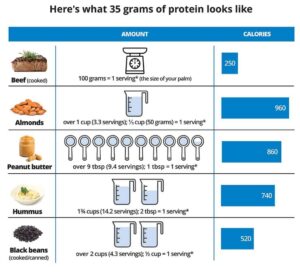Nutritional Qualities of Beef

It’s important to understand how what we eat impacts our health and daily life but it can be hard to sift through the volume of information – and disinformation – that is out there. The BCRC has updated a web page that focuses on facts about beef nutrition. We also encourage you to check out www.thinkbeef.ca, which contains current Canadian beef nutritional information.
Beef is increasingly being portrayed as an optional protein however beef contains a total package of nutrients that are essential at every life stage. Beef contains essential nutrients including protein, iron, zinc, selenium, riboflavin, niacin, vitamin B6, vitamin B12, phosphorus, pantothenate, magnesium, and potassium. It is impossible to get this combination of nutrients, in a single, dense package, from plant-based foods. In fact, a recent Canadian study demonstrates that gram-for-gram, beef is more nutrient dense and more economical than many other protein foods.
Dietary Patterns
Canadian diets are changing and not necessarily for the better. Nutritional guidelines are largely based on whole ingredients and home-cooked foods, however today, more foods than ever are processed, packaged, and eaten with minimal home-preparation. On average, Canadians are consuming nearly half of their daily calories from ultra-processed foods, which are often high in sodium, fat, calories, and sugar. Meanwhile, only five per cent of their calories are consumed from nutrient-rich red meat, such as beef.
It’s not surprising that many Canadians are nutritionally deficient. For example, vitamin B12 and zinc intake are inadequate in 10-35% of men and women, and iron is inadequate for 16-19% of women aged 19 to 50. In Canadian men aged 70 and older, 41% are deficient in zinc. Recent dietary evidence also showed that 48% of Canadian women ages 31-50, 69% of women aged 70 years and older, and 56% of adolescent males do not eat the recommended amount (grams or servings) of meat and protein alternatives.
The Benefits of Beef
Adding beef to a meal can have a synergistic benefit for iron absorption, known as the “Meat Factor.” For example, adding beef to a bean dish increases iron absorption by 150% than a vegetable-only type.
Certain nutrients in beef may be absorbed more readily than nutrients in other foods. For example, iron from beef is in “heme” form and more easily absorbed and used by the body than iron from other sources such as spinach, legumes, or eggs. Beef can also have a synergistic benefit, sometimes known as the “Meat Factor”. When beef is added into certain meals, it increases absorption of iron from other foods or ingredients like plant-based proteins and vegetables. For example, adding ground beef to a bean dish allows an individual to absorb 150% more iron than a vegetable-only version. This is just one example of a balanced diet that contains both plant- and animal-sourced foods
The nutritional benefits of a balanced, diverse diet that includes whole foods such as protein foods like beef, and whole vegetables and fruits, and whole grains, is greater than the sum of their parts.
Beef and Your Health
The effect of diet on health is widely studied around the world and there are plenty of high-profile studies with conflicting results. Most studies do agree, however, that ultra-processed foods of all types, can increase health risks.
In a recent large-scale analysis of nutritional studies that assessed 54,000 individuals, experts determined that there was not a significant association between meat consumption and heart disease, cancer, or diabetes.
Red meats, including beef, can be an important part of a healthy diet to manage diabetes. Whole foods that are high in protein, like beef, can also play a role in an overall wellness strategy for people looking to lose weight. Beef can help people retain muscle mass and stay full for longer at a lower calorie count per nutrient than many other protein foods.
Protein, Iron, and Fat
Beef is a very efficient source of protein that is bioavailable and ready for the body to metabolize.

Your body needs twenty amino acids to function and thrive, however nine of those are essential amino acids that must come from dietary sources. Protein found in beef and other meats are “complete” proteins because they contain all the essential amino acids humans require. Plant-based proteins are “incomplete” proteins because they don’t contain a full set of amino acids. Plant-based proteins are typically high in carbohydrates relative to protein and the protein is less digestible. For example, 100 grams of cooked beef will provide 35 grams of protein with just 250 calories, whereas it would take more than 9 tablespoons of peanut butter, at 860 calories, to provide the same amount of protein.
Worldwide, iron deficiency is a concern, including right here in Canada. Iron needs are greatest during growth (infancy and teens) and for women during their childbearing years. Fortunately, beef is one of the best natural heme iron-rich foods available. Babies also depend on iron for best brain development and growth. Babies require 11 mg of iron per day yet their tummies are small. Beef contains bioavailable heme-iron, the most digestible form of iron for humans, which is why Health Canada recommends beef as a top choice for a first solid food for babies.
Beef contains bioavailable heme-iron, the most digestible form of iron for humans, which is why Health Canada recommends beef as a top choice for a first solid food for babies.
Unsaturated fats, such as monounsaturated and polyunsaturated fats are “healthy” fats that are important components of a well-balanced diet. More than half (55%) of the fat in beef is unsaturated and most of the unsaturated fat in beef is oleic acid, the same type of “healthy” fat found in olive oil.
Trimming visible fat on whole cuts of beef, draining ground beef after cooking, or preparing beef on a grill can all reduce total fat content.
Balance is the key when it comes to healthy eating. Beef provides high-quality protein without a lot of calories, compared to alternatives. You can’t substitute beef with an equivalent nutrient-dense source of essential nutrients like zinc, iron, and protein, because there is no food just like beef.
To learn more about beef nutritional value, as well as find sources for facts, visit the new web page.
Click here to subscribe to the BCRC Blog and receive email notifications when new content is posted.
The sharing or reprinting of BCRC Blog articles is welcome and encouraged. Please provide acknowledgement to the Beef Cattle Research Council, list the website address, www.BeefResearch.ca, and let us know you chose to share the article by emailing us at info@beefresearch.ca.
We welcome your questions, comments and suggestions. Contact us directly or generate public discussion by posting your thoughts below.